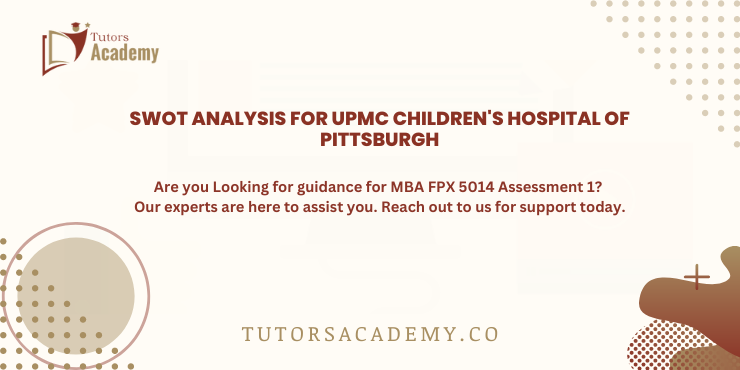
- MBA FPX 5014 Assessment 1
Executive Summary Table
| Action Step | Description | Resource Information |
| 1. Current Organization – Background | UPMC Children’s Hospital of Pittsburgh is a leading pediatric hospital providing comprehensive medical care to children. It is renowned for its pediatric specialties and advanced care. The hospital is committed to delivering the highest quality of care, ensuring patient safety, and adhering to regulatory requirements. | UPMC Children’s Hospital of Pittsburgh. (n.d.). About Us. Retrieved from UPMC Children’s Hospital |
| 2. Philosophy or Culture Statement | Mission: To improve the health and well-being of children through excellence in patient care, teaching, and research.Vision: To be a global leader in pediatric healthcare, providing innovative and compassionate care to all children. Values: Integrity, excellence, teamwork, compassion, and accountability. | UPMC Children’s Hospital of Pittsburgh. (n.d.). Mission, Vision, Values. Retrieved from UPMC Children’s Hospital |
| 3. Regulatory Requirements and Anticipated Future Changes | Current Requirements:– Patient Protection and Affordable Care Act (ACA): Ensures affordable and quality healthcare. – Centers for Medicare & Medicaid Services (CMS): HACs lead to no reimbursement. – Joint Commission Standards: Focus on patient safety and quality improvement. –Anticipated Future Changes: Stricter penalties and additional reporting requirements. | Centers for Medicare & Medicaid Services (CMS). (n.d.). Hospital-Acquired Conditions (HACs). Retrieved from CMS.gov; Joint Commission. (n.d.). Standards for Hospital Accreditation. Retrieved from Joint Commission |
| 4. Identify a Gap in Compliance for the Chosen Organization | UPMC Children’s Hospital of Pittsburgh has a high incidence of HACs, which affects patient safety and leads to financial penalties. | Internal hospital reports on HAC incidence rates. |
| 5. Assess Your Chosen Organization’s Regulation Gap through a DMAIC Lens | Define: HACs are a critical issue affecting patient safety and hospital reimbursements.Measure: Incidence rates of HACs, patient outcomes, and compliance levels. Analyze: Identify root causes such as inadequate staff training and inconsistent adherence to protocols. Improve: Implement targeted training programs and standardized procedures. Control: Regular audits and continuous monitoring to sustain improvements. | Internal quality improvement and risk management reports. |
| 6. What Recommendations Do You Have Based on your Analysis? | Enhance staff training, standardize procedures, invest in technology, and foster a culture of safety. | Best practices in healthcare quality improvement. |
| 7. What Challenges Will You Face When Bringing Forth Your Recommendations? | Resistance to change among staff, ensuring uniform implementation across all departments, and allocating sufficient resources for training and technology upgrades. | Change management literature and case studies. |
| 8. How Will You Measure and Monitor Your Recommendations? | Identify metrics such as HAC incidence rates, patient safety indicators, and staff compliance rates. Use outcome data to identify trends and adjust strategies for continuous improvement. | Data analytics and monitoring tools. |
| 9. How Is the Organization Legally Obligated to Comply with This Regulation? | Ensuring patient safety is a legal requirement under regulations like the ACA and CMS guidelines. Non-compliance results in financial penalties and potential legal action. | Centers for Medicare & Medicaid Services (CMS). (n.d.). Regulatory compliance guidelines. Retrieved from CMS.gov |
| 10. How Is the Organization Ethically Obligated to Comply with This Regulation? | Upholding patient safety and delivering quality care is an ethical obligation. Transparency, accountability, and maintaining patient trust are essential. | Ethical standards in healthcare literature. |

SWOT Analysis for UPMC Children’s Hospital of Pittsburgh
| Strengths | Weaknesses |
| – Leading pediatric care provider- Strong commitment to quality improvement – Advanced technology and medical research | – High incidence of HACs affecting patient safety- Limited resources for extensive staff training on new regulations – Challenges in consistently implementing best practices across all departments |
| Opportunities | Threats |
| – Potential for obtaining accreditation for exceeding care standards- Expansion of risk management programs and staff training – Collaboration with other healthcare institutions for benchmarking | – Changing regulatory landscape requiring constant updates to compliance strategies- Financial penalties and reimbursement issues related to HACs – Negative impact on hospital reputation due to non-compliance |
MBA FPX 5014 Assessment 1 Executive Summary Table
If you need complete information about class 5014, click below to view a related sample:
MBA FPX 5010 Assessment 3 Environmental Analysis
References
Arias, P. A., Bellouin, N., Coppola, E., Jones, R. G., Krinner, G., Marotzke, J., Naik, V., Palmer, M. D., Plattner, G.-K., Rogelj, J., Rojas, M., Sillmann, J., Storelvmo, T., Thorne, P. W., Trewin, B., Rao, K. A., Adhikary, B., Allan, R. P., Armour, K., & Bala, G. (2021). Technical summary (V. P. Masson-Delmotte, A. Zhai, S. L. Pirani, & C. Connors, Eds.). Centaur.reading.ac.uk; Cambridge University Press.
https://centaur.reading.ac.uk/101322/
Arnett, D. K., Blumenthal, R. S., Albert, M. A., Buroker, A. B., Goldberger, Z. D., Hahn, E. J., Himmelfarb, C. D., Khera, A., Lloyd-Jones, D., McEvoy, J. W., Michos, E. D., Miedema, M. D., Muñoz, D., Smith, S. C., Virani, S. S., Williams, K. A., Yeboah, J., & Ziaeian, B. (2019). 2019 ACC/AHA guideline on the primary prevention of cardiovascular disease: Executive summary. Journal of the American College of Cardiology, 74(10), 1376–1414.
https://doi.org/10.1016/j.jacc.2019.03.009
Reddel, H. K., Bacharier, L. B., Bateman, E. D., Brightling, C. E., Brusselle, G. G., Buhl, R., Cruz, A. A., Duijts, L., Drazen, J. M., FitzGerald, J. M., Fleming, L. J., Inoue, H., Ko, F. W., Krishnan, J. A., Levy, M. L., Lin, J., Mortimer, K., Pitrez, P. M., Sheikh, A., & Yorgancioglu, A. A. (2021). Global initiative for asthma (GINA) strategy 2021 – executive summary and rationale for key changes. American Journal of Respiratory and Critical Care Medicine, 205(1).
https://doi.org/10.1164/rccm.202109-2205pp
Rossing, P., Caramori, M. L., Chan, J. C. N., Heerspink, H. J. L., Hurst, C., Khunti, K., Liew, A., Michos, E. D., Navaneethan, S. D., Olowu, W. A., Sadusky, T., Tandon, N., Tuttle, K. R., Wanner, C., Wilkens, K. G., Zoungas, S., Craig, J. C., Tunnicliffe, D. J., Tonelli, M. A., & Cheung, M. (2022). Executive summary of the KDIGO 2022 clinical practice guideline for diabetes management in chronic kidney disease: An update based on rapidly emerging new evidence. Kidney International, 102(5), 990–999.
https://doi.org/10.1016/j.kint.2022.06.013
Shuhart, C. R., Yeap, S. S., Anderson, P. A., Jankowski, L. G., Lewiecki, E. M., Morse, L. R., Rosen, H. N., Weber, D. R., Zemel, B. S., & Shepherd, J. A. (2019). Executive summary of the 2019 ISCD position development conference on monitoring treatment, DXA cross-calibration and least significant change, spinal cord injury, peri-prosthetic and orthopedic bone health, transgender medicine, and pediatrics. Journal of Clinical Densitometry, 22(4), 453–471.
https://doi.org/10.1016/j.jocd.2019.07.001
Stevens, S. M., Woller, S. C., Baumann Kreuziger, L., Bounameaux, H., Doerschug, K., Geersing, G.-J., Huisman, M. V., Kearon, C., King, C. S., Knighton, A. J., Lake, E., Murin, S., Vintch, J. R. E., Wells, P. S., & Moores, L. K. (2021). Antithrombotic therapy for VTE disease: Second update of the CHEST guideline and expert panel report – executive summary. Chest, 160(6).
https://doi.org/10.1016/j.chest.2021.07.056
